
Boraginaceae, the borage or forget-me-notfamily, includes about 2,000 species of shrubs, trees, and herbs in 146 to 154 genera with a worldwide distribution.

Pulmonaria (lungwort) is a genus of flowering plants in the family Boraginaceae, native to Europe and western Asia, with one species east to central Asia. According to various estimates there may be between 10 and 18 species found in the wild.
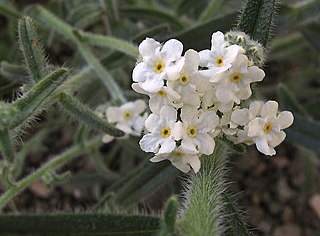
Cryptantha is a genus of flowering plants in the borage family, Boraginaceae. They are known commonly as cat's eyes and popcorn flowers. They are distributed throughout western North America and western South America, but they are absent from the regions in between.

Boraginales is an order of flowering plants in the asterid clade, with a total of about 125 genera and 2,700 species. Different taxonomic treatments either include only a single family, the Boraginaceae, or divide it into up to eleven families. Its herbs, shrubs, trees and lianas (vines) have a worldwide distribution.
Hoplestigma is a genus of flowering plants in the family Boraginaceae, although this is disputed, and it has been placed in its own family Hoplestigmataceae. Its two species are native to Cameroon, Gabon, Ivory Coast and Liberia in western tropical Africa.

Oreocarya virginensis is a species of wildflower in the family Boraginaceae known by the common name Virgin River cryptantha. This is a small plant native to the southwestern United States where it is a common plant in scrub and woodland. It is named for the Virgin River, a tributary of the Colorado River which runs through the region. This cryptantha is an annual or occasionally a perennial up to 40 centimeters in height. It is coated densely in long white hairs and bristles. The inflorescence is cylindrical or club-shaped, packed with tubular flowers with flat-faced corollas. The flower is usually bright white with yellow throat parts at the tube opening. The fruit is a rough, ridged nutlet.
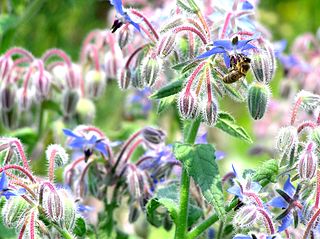
Boraginoideae is a subfamily of the plant family Boraginaceae s.s, with about 42 genera. That family is defined in a much broader sense in the Angiosperm Phylogeny Group (APG) system of classification for flowering plants. The APG has not specified any subfamilial structure within Boraginaceae s.l.

Greeneocharis circumscissa is a species of flowering plant in the borage family, known by the common name cushion cryptantha. It is native to western North America from Washington to Baja California to Colorado and it is also found in Argentina. It grows in sandy or gravelly types of habitat, from mountains to desert, below 9,500 m (31,200 ft) above sea level.
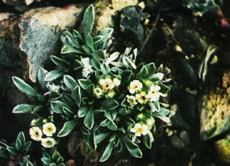
Oreocarya roosiorum is a species of flowering plant in the family Boraginaceae known by the common name bristlecone cryptantha.

Codon is a small genus of plants from South Africa in the family Codonaceae in the order Boraginales. The genus Codon comprises two species.
Heliotropiaceae are a cosmopolitan family of flowering plants with approximately 450 species worldwide, though it is concentrated especially in the tropics and subtropics.
Oreocarya nubigena, synonym Cryptantha nubigena, is a perennial plant in the borage family (Boraginaceae), native to western North America. It may be called the Sierra cryptantha and Sierra oreocarya.
Selkirkia is a genus of flowering plants in the family Boraginaceae. Three species occur on the South American mainland and one, Selkirkia berteroi, the first of the genus to be reported, is an endemic on Robinson Crusoe Island off the coast of Chile. It was previously considered a monotypic genus.
Johnstonella is a genus of flowering plants belonging to the family Boraginaceae.

Huynhia is a genus of flowering plants belonging to the family Boraginaceae, from Asia.
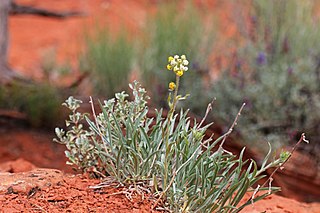
Oreocarya is a genus of flowering plants in the family Boraginaceae. There are about 63 species and its native range extends from western and central Canada, through western United States to north Mexico. It is part of subtribe of Amsinckiinae.
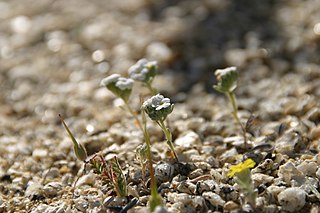
Eremocarya is a genus of flowering plants in the family Boraginaceae. There are two species and its native range extends through the western United States and Texas to northwestern Mexico. It is part of subtribe of Amsinckiinae.

Myosotis brevis is a species of flowering plant in the family Boraginaceae, endemic to New Zealand. George Simpson and J.S. Thomson described M. pygmaea var. minutiflora in 1942, and Peter de Lange and John Barkla recognized it at species rank in 2010, as M. brevis. Plants of this species of forget-me-not are small and annual, with a prostrate habit, bracteate inflorescences, tiny white corollas, and brown or green leaves.
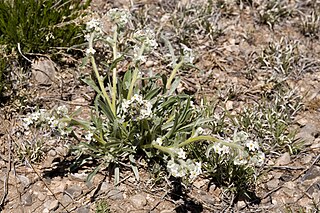
Oreocarya suffruticosa is a species of flowering plant in the family Boraginaceae, native to the west and central United States and to northern Mexico. It was first described by John Torrey in 1827 as Myosotis suffruticosa and transferred to Oreocarya by Edward Lee Greene in 1887. Varieties of Oreocarya suffruticosa have previously been placed within several species of Cryptantha, including Cryptantha cinerea, Cryptantha jamesii and Cryptantha pustulosa.
Amsinkiopsis is a monotypic genus of flowering plants in the borage family consisting of the species Amsinckiopsis kingii. A. kingii was previously considered part of the genus Plagiobothrys, until phylogenetic study proved the genus to be polyphyletic.














